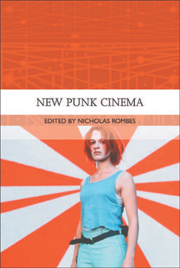Book contents
- Frontmatter
- Contents
- Notes on the Contributors
- Acknowledgements
- Introduction
- PART I BACKGROUNDS AND CONTEXTS
- PART II SCREENING NEW PUNK CINEMA
- 5 DVD and the New Cinema of Complexity
- 6 Digital Technologies and the Poetics of Performance
- 7 Navigating Chaos
- 8 Non-linear Narrative
- 9 Making it Real
- PART III CASE STUDIES
- Bibliography
- Index
6 - Digital Technologies and the Poetics of Performance
from PART II - SCREENING NEW PUNK CINEMA
Published online by Cambridge University Press: 05 August 2013
- Frontmatter
- Contents
- Notes on the Contributors
- Acknowledgements
- Introduction
- PART I BACKGROUNDS AND CONTEXTS
- PART II SCREENING NEW PUNK CINEMA
- 5 DVD and the New Cinema of Complexity
- 6 Digital Technologies and the Poetics of Performance
- 7 Navigating Chaos
- 8 Non-linear Narrative
- 9 Making it Real
- PART III CASE STUDIES
- Bibliography
- Index
Summary
Utopian and dystopian discourses have accompanied the rise of digital techniques of cinematic production and post-production. While some enthusiastic directors, film critics and spectators have found that digital technologies have already reshaped cinema, others, offering a more temperate, almost Luddite perspective, believe that digital technologies have not brought substantial changes and will not modify the cinematic experience as we know it. In other words, a century after the birth of cinema, digital technologies might show the limits of celluloid and traditional montage practices, but they will remain in a state of infancy that does not call for the revolution in cinematic practice foretold by many.
What I propose in this essay is to adopt a more balanced approach to the use of digital technologies in contemporary films, bearing in mind that Utopian and dystopian positions are complementary rather than mutually exclusive. Digital technologies have favoured a certain democratisation and transformation of cinema: new film-makers direct their first films at minimal cost, and more experienced directors perform technological ‘tricks’ that may not have been possible prior to the advent of digital media. Digital technologies, however, do not erase a century of film-making practices and cinematic heritage overnight. Issues of representation, mise-en-scéine, montage and performance do not disappear with the advent of digital media; they come back to life in forms that are mediated in a new way. Dogma 95 and new punk films exemplify the manner in which contemporary cinema has used digital media creatively but without breaking with the cinematic past.
- Type
- Chapter
- Information
- New Punk Cinema , pp. 102 - 112Publisher: Edinburgh University PressPrint publication year: 2005

